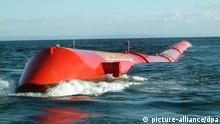The idea of harnessing the power of the waves to produce electricity is not new, but now this renewable energy source is finally making a breakthrough. Pioneers are feeding wave power into the grid off Scotland's coast.
Beneath the cliffs at Billia Croo on the Scottish island of Orkney, a number of unusual devices are being tested as energy producers. A yellow object, for example, bobs on the sea and serves as the tip of a hydroelectric wave energy converter. At a depth of fifteen meters (49 feet), a large platform is attached to the seabed, bearing a flap that moves up and down with the waves.
This device pumps water at high pressure to shore, where it produces electricity for the grid with the help of a turbine. It's called the "Oyster" and was developed by Aquamarine Power, a Scottish company headquartered in Edinburgh.
This device pumps water at high pressure to shore, where it produces electricity for the grid with the help of a turbine. It's called the "Oyster" and was developed by Aquamarine Power, a Scottish company headquartered in Edinburgh.
Further out at sea, a long, red object undulates with the waves like a giant sea snake. Dubbed "Pelamis," it is a floating, miniature power station, measuring four meters in diameter and 180 metres long - about the size of five carriages on an intercity train, explained Richard Yemm, inventor of the system and head of the company Pelamis Wave Power.
The Pelamis consists of several segments, linked by joints. As they are moved by the waves, generators inside the device produce electricity, which is transferred to shore by a sub-sea cable. At the company's headquarters in Leith, outside of Edinburgh, Yemm's team monitors the output with data transferred by optical fiber cables. For maintenance or repair, the "sea snake" can be unplugged and towed to the coast.
No such thing as bad weather?
The opportunity of testing these different prototypes in the rough waters of Orkney comes thanks to the European Marine Energy Center (EMEC). In nearby Stromness, the Scottish and British governments and the European Commission joined forces in 2003 to set up the world's first facility for testing wave and tidal energy in real sea conditions, but with a direct link to the national grid. Developers who produce electricity from the sea there are able to sell it.

The Pelamis converts wave energy into electricity
But the challenge along the way is to make machinery capable of surviving in a very hostile environment, according to Neil Davidson of Aquamarine Power. Along the Scottish coast, the devices can be tested in stormy weather and with waves up to 17 meters.
The site serves as a kind of laboratory, where different methods are being tested. The tidal power devices each use some form of turbine, said Eileen Linklater, marketing manager at EMEC. Since the devices are being developed for different locations and water depths, it is possible that several different systems will become commercially viable.
EON, Scottish Power Renewables, Vattenfall, ABB, Kawasaki - all of the big international names in the power sector are investing in the promising technologies being tested in Orkney.
By 2020, Scottish leaders want to cover 100 percent of the country's electricity consumption with renewable sources - and to export the excess power.
Money matters
Wave energy is still too expensive to compete with other renewable sources. The costs will have to decrease for the new power source to be competitive with on-shore wind, said Roy Kirk of Highlands and Islands Enterprise (HIE), the government agency promoting economic development in the region. But Kirk thinks costs could sink within the next ten years.Research and development for new technologies involve high investment costs. The rapid progress that has been made in Scotland would have been unthinkable without massive support from the government. A combination of grants, loans and feed-in tariffs alongside the provision of well-studied development sites along the coasts provided developers plenty of incentives.
Large international companies are not just investing in wave energy due to green political agendas, the energy expert said, noting that they clearly expect profits in the future. The next step would be for marine energy to bring its price into line with that of off-shore wind, which is still considerably more expensive than on-shore wind.
Island electricity for the mainland

Wave energy might eventually help power huge cities like Tokyo
One prerequisite for the success of marine power is upgrading the British national grid, which was constructed around fifty or sixty years ago to transport power from coalfields into the industrial heartlands of Scotland and England, said Energy Minister Fergus Ewing.
Orkney is located at Scotland's northernmost point. The country's grid was built with the expectation of providing small, remote communities with electricity. If such areas are now to become large-scale energy providers, the grid will have to be upgraded to transport energy in the opposite direction.
Marine energy is regarded as a reliable, predictable addition to wind and solar energy. In the next few years, arrays of devices will be linked up to form large wave farms. In an ideal scenario for developers, the devices able to survive in the wild conditions off Orkney could be deployed all over the world, providing coastal megacities with an endless source of climate-friendly electricity.
Eileen Linklater from EMEC says the wave generators will undergo quite a few modifications before they become commercially successful. She believes that could be within ten or 15 years, depending on political support and investment. Pelamis Wave Power and Aquamarine Power expect to be producing electricity on a commercial scale between 2020 and 2030.
China and Japan are showing considerable interest in what's happening in Orkney. The idea is to demonstrate the potential of wave power here, says Pelamis inventor Richard Yemm - then replicate that success around the world.
No comments:
Post a Comment